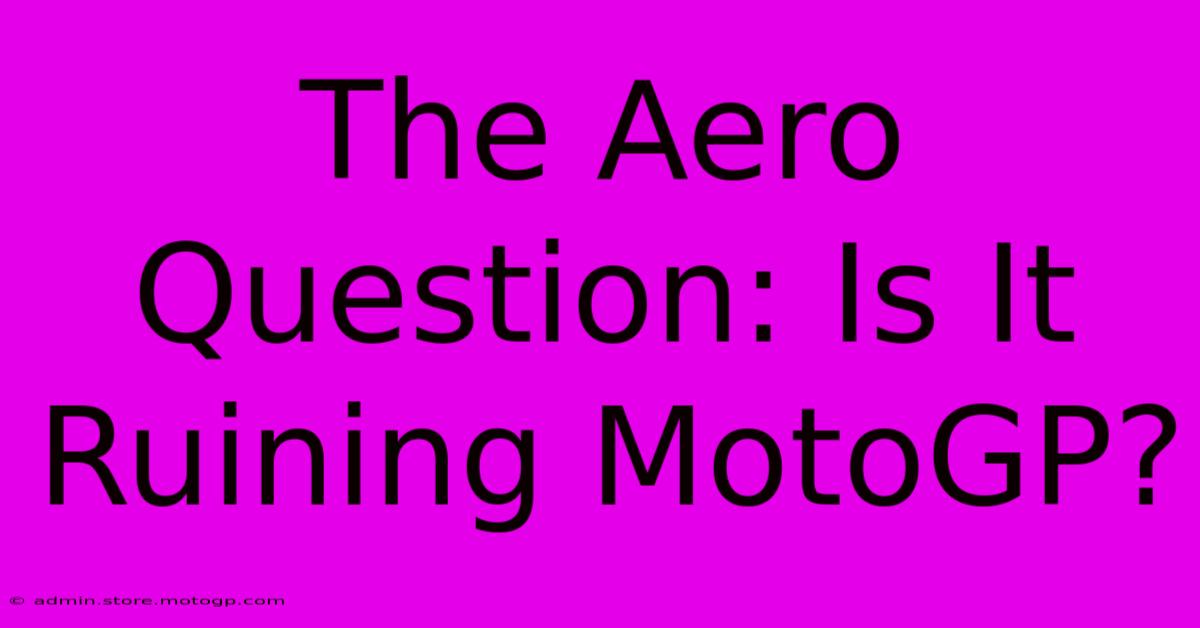The Aero Question: Is It Ruining MotoGP?

Table of Contents
The Aero Question: Is It Ruining MotoGP?
The roar of MotoGP engines is legendary, but a new sound is increasingly dominating the conversation: the whisper of aerodynamic wings. While aero advancements have always played a role in motorcycle racing, the current level of sophistication raises a crucial question: is it ruining the sport? This article delves into the controversies surrounding aerodynamics in MotoGP, exploring its impact on racing, rider safety, and the overall spectacle.
The Rise of the Wings: A Technological Arms Race
The introduction of winglets and aerodynamic appendages wasn't a sudden shift. It's been an incremental evolution, with each manufacturer pushing the boundaries to gain a competitive edge. This technological arms race has led to increasingly complex and elaborate aerodynamic designs, transforming MotoGP bikes into futuristic machines. These aren't just cosmetic additions; they significantly impact handling, stability, and ultimately, race results.
The Advantages: Grip, Stability, and Speed
The primary benefit of advanced aerodynamics is increased downforce. This extra grip allows riders to carry more speed through corners, reducing braking distances and enabling faster lap times. Improved stability at high speeds enhances rider confidence and reduces the risk of high-side crashes, a common hazard in MotoGP. Essentially, aero packages give riders a significant advantage, allowing them to push harder and faster.
The Disadvantages: Cost, Complexity, and Reduced Spectacle
However, the advantages don't come without drawbacks. The development and production of these complex aerodynamic systems are incredibly expensive, potentially widening the gap between factory teams and smaller satellite teams. This cost barrier could stifle innovation from smaller teams and limit competition, harming the overall health of the sport.
Furthermore, some argue that the increased downforce reduces the skill required for cornering. The bikes are so stable that riders can push the limits with less finesse, leading to less exciting and unpredictable races. The emphasis shifts from rider skill to aerodynamic efficiency, potentially diminishing the raw talent displayed by the riders themselves. The visual impact is also debated. Some feel the intricate designs are aesthetically pleasing, others believe they clutter the sleek lines of the bikes.
Safety Concerns: A Double-Edged Sword
Aerodynamics present a complex safety equation. While increased stability reduces the likelihood of high-side crashes, the increased speeds and downforce create new challenges. Collisions at such high speeds can be more devastating, and the complex aerodynamic components themselves pose a risk in crashes. Debris from damaged wings can cause further accidents, adding another layer of concern.
The Future of Aero in MotoGP: Finding a Balance
The governing body, Dorna Sports, is continually wrestling with the challenges posed by aerodynamic development. Regulations are regularly updated to try and control the escalation, but a delicate balance needs to be struck. Too much restriction could stifle innovation and technological advancement, while too little could lead to an unsustainable arms race.
Finding a balance that promotes competition, ensures rider safety, and maintains the exciting spectacle of MotoGP racing is a constant challenge. The future likely lies in a sophisticated approach to regulation that encourages innovation while preventing an excessive escalation of cost and complexity. This might involve stricter testing protocols, limitations on design freedom, and potentially, a more standardized approach to aerodynamic components.
In conclusion, the impact of aerodynamics on MotoGP is undeniable. While it provides significant advantages in terms of speed and stability, it also raises concerns about cost, competitiveness, and even rider safety. The ongoing debate underscores the complex relationship between technological advancement and the essence of motorsport. The future of MotoGP hinges on finding a balance that ensures the sport remains exciting, competitive, and safe for years to come.

Thank you for visiting our website wich cover about The Aero Question: Is It Ruining MotoGP?. We hope the information provided has been useful to you. Feel free to contact us if you have any questions or need further assistance. See you next time and dont miss to bookmark.
Featured Posts
-
The Art Of Moto Gp Racing Mastering The Track
Feb 21, 2025
-
Ex Factory Race Bikes Beyond Ordinary
Feb 21, 2025
-
Sprint Race Results The Biggest Upset Of The Year
Feb 21, 2025
-
Moto Gp Watch Get Ready To Rumble
Feb 21, 2025
-
F1 Grid Analysis Using The Formula For Better Predictions
Feb 21, 2025
